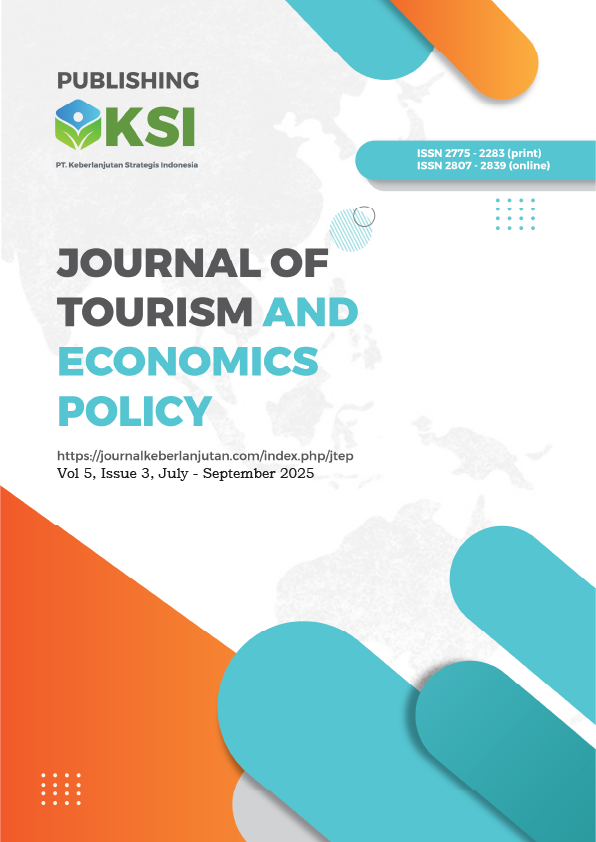Tourism Villages: Developing Tourist Attractions Based on Environmental Conservation for Sustainable Tourism
DOI:
https://doi.org/10.38142/jtep.v5i4.1365Keywords:
Tourist Attraction, Sustainable Tourism, Natural Environment, Cultural Environment, Economic EnvironmentAbstract
Tourism villages are tourism activities that are considered as a means of preserving nature and cultural heritage of certain communities. Tourism villages are considered to be able to create sustainable tourism that is beneficial to the local community. This researcher aims to explain the form of development of environmentally friendly tourist attractions in Asinan Tourism Village and its contribution to sustainable tourism. The research method uses qualitative research with data collected through informants, observation and document studies. The data is analyzed through an inductive process to be able to draw a number of conclusions. The results of the study stated that the development of tourist attractions in Asinan Village relies on the wealth of environmental resources, both the natural environment, socio-culture and the economy of the swamp fishing community. Tourism attractions based on the swamp environment include natural tourism, cultural tourism typical of swamp fishermen, artificial tourism, culinary tourism, and educational tourism. Managed tourist attractions play a role in the preservation of the natural environment, cultural environment, economic environment and community empowerment.
References
Agung, A. A. G. N. J. (2021). Management Model of Traditional Village-based Tourism Objects in the Perspective of Tourism Law. Proceedings of the 2nd International Conference on Business Law and Local Wisdom in Tourism (ICBLT 2021), 605, 21–25. https://doi.org/10.2991/assehr.k.211203.005
Ashley, C., Brine, P. De, Lehr, A., & Wilde, H. (2007). The Role of the Tourism Sector in Expanding Economic Opportunity. The Role of the Tourism Sector in Expanding Economic Opportunity, 11–15.
Chambers, E. (2009). From authenticity to significance: Tourism on the frontier of culture and place. Futures, 41(6), 353–359. https://doi.org/10.1016/j.futures.2008.11.003
Farhan, H., & Anwar, K. (2016). The Tourism Development Strategy Based on Rural and Local Wisdom. Journal of Sustainable Development, 9(3), 170. https://doi.org/10.5539/jsd.v9n3p170
Juma, L. O., & Khademi-Vidra, A. (2019). Community-based tourism and sustainable development of rural regions in Kenya; Perceptions of the citizenry. Sustainability (Switzerland), 11(17). https://doi.org/10.3390/su11174733
Kachniewska, M. A. (2015). Tourism development as a determinant of quality of life in rural areas. Worldwide Hospitality and Tourism Themes, 7(5), 500–515. https://doi.org/10.1108/WHATT-06-2015-0028
Li, L., & Li, S. (2022). Do Tourists Really Care about Authenticity? A Study on Tourists’ Perceptions of Nature and Culture Authenticity. Sustainability (Switzerland), 14(5). https://doi.org/10.3390/su14052510
Lian, J. C. K., & Xin, T. K. (2023). An Analysis of the COVID-19 Pandemic on Kota Kinabalu as a Tourism City: Impacts, Mitigation Measures and Recommendations. Asia-Pacific Journal of Innovation in Hospitality and Tourism, 12(1), 49–69.
O’Donnell, P. M. (2016). Cultural landscape preservation: An evolving field. Landscape Journal, 35(2), 203–217. https://doi.org/10.3368/lj.35.2.203
Priatmoko, S., Kabil, M., Purwoko, Y., & Dávid, L. D. (2021). Rethinking sustainable community-based tourism: A villager’s point of view and case study in Pampang Village, Indonesia. Sustainability (Switzerland), 13(6), 1–15. https://doi.org/10.3390/su13063245
Rahman, S. S., & Baddam, P. R. (2021). Community Engagement in Southeast Asia’s Tourism Industry: Empowering Local Economies. Global Disclosure of Economics and Business, 10(2), 75–90. https://doi.org/10.18034/gdeb.v10i2.715
Ryan, C., & Huimin, G. (2008). Tourism in China: Destination, cultures and communities. In Tourism in China: Destination, Cultures and Communities (pp. 1–399). Taylor & Francis. https://doi.org/10.4324/9780203886366
Sitorus, N. B., Liyushiana, L., & Khairi, N. (2024). Sustainable Tourism Management for Enhanced Tourism Product Quality in the Cultural Village of Dokan. Jurnal Ilmiah Global Education, 5(1), 27–36. https://doi.org/10.55681/jige.v5i1.2291
Stefaniak, C., Paulauskaite, D., Powell, R., Coca-stefaniak, J. A., & Alastair, M. (2017). To cite this article , please use the following format : Living Like a Local : Authentic Tourism Experiences and the Sharing Economy. 19, 619–628.
Van, B. T. (2024). The Role of Cultural Tourism in the Preservation and Promotion of Traditional Cultural Values among Ethnic Minority Groups in Tuyên Quang. European Journal of Arts, Humanities and Social Sciences, 1(3), 355–360. https://doi.org/10.59324/ejahss.2024.1(3).31
Waluya, B., Malihah, E., Ruhimat, M., & Wiyanarti, E. (2022). Tourism Revitalization Based on Local Wisdom in ‘Saba Budaya’ of Baduy. Jurnal Geografi Gea, 22(1), 1–13. https://doi.org/10.17509/gea.v22i1.45571
Wulandari, P. K., Baiquni, M., & Zubaidi, A. (2024). Preserving and Managing Chinese Settlement Heritage Tourism in Lasem, Indonesia. Geojournal of Tourism and Geosites, 55(3), 1055–1065. https://doi.org/10.30892/gtg.55307-1279
Yanti, D., Heryadi, D. Y., Juliana, Cakranegara, P. A., & Kadyrov, M. (2023). Developing rural communication through digital innovation for village tourism. Jurnal Studi Komunikasi (Indonesian Journal of Communications Studies), 7(3), 696–712. https://doi.org/10.25139/jsk.v7i3.7384
Downloads
Published
Issue
Section
License
Copyright (c) 2025 Sonia GEE, Haniek LISTYORINI

This work is licensed under a Creative Commons Attribution-NonCommercial 4.0 International License.
Creative Commons Attribution-NonCommercial 4.0 International License.





















